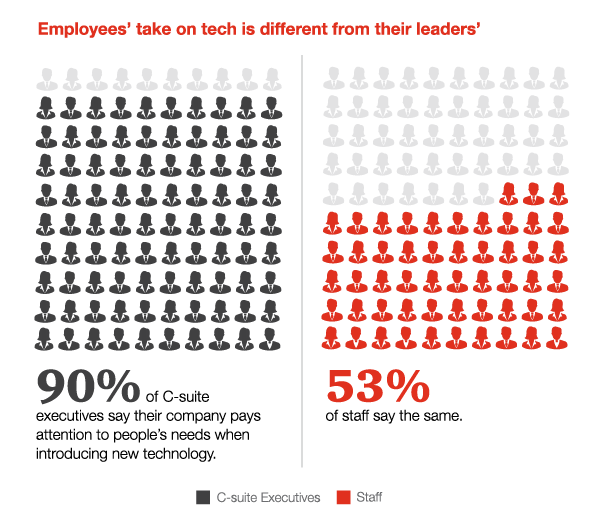The ‘Great Reshuffle’ is a period of change in the workplace unlike anything we’ve experienced in the 21st century. Business leaders are completely rethinking business models, working cultures and company values. Employees are rethinking how, where, when and why they work, and how these factors contribute to their work/life continuum.
The balance of power has shifted. The ‘top-down’ culture where C-level management determines goals, processes, projects, and tasks in the workplace is being discarded in favor of employee input, participation, and flexibility.
What’s changing?
Technology is at the core of a newer more dynamic relationship between employers and employees and is enabling the hybrid working (work-from-anywhere) paradigm to flourish.
In our eBook, Putting Your Employees First in the Work-From-Anywhere-Model, we explore the evolution of employer/employee relationship in the hybrid workplace. In this blog, we’ll dig a little deeper and investigate the rising demand from employees for the implementation of ‘best in class’ technologies.
Tech and people – a love/hate relationship
Technology usage these days is not just a means to an end; it’s a complete experience. Employees can strengthen their connection through technology, and the mindset they have, around what technology can provide.
Tech, if implemented the right way, has the potential to increase work skills, enhance user satisfaction and productivity, save time and money, and give organizations a competitive edge. It also encourages staff retention, as well as attracting the best talent to your organization.
It comes down to the question of whether employees are satisfied with the technology experience their company provides. It also depends on the confidence and skill level of the persons use of and with the tech.
According to a study by PWC, 90% of C-suite execs claim that their company does consider their people’s needs when introducing new technology, but only 53% of employees agree. This could explain why many employees seek to use their own mobile and cloud-based applications and devices.
While this may enhance an employee’s ability to do their job, the main problem is that the use of unsanctioned tools makes it extremely complex to monitor and safeguard an organization’s data.

Bridging the user experience gap
New technology can be frustrating and unfamiliar. User adoption can be slow, and often employees are left to fend for themselves when trying to figure out how to implement it.
A below-average employee experience can affect an entire organization, impacting engagement and enthusiasm, as well as customer service and satisfaction. It can also have a knock-on effect by draining resources from other departments including IT and HR. Sorting out employee grievances over inadequate training or lack of understanding can waste valuable time and money.
So how do business leaders bridge this gap and make sure the technology fits the needs of their organization while at the same time keep their employees comfortable and engaged?
The answer could lie in awarding employees a stronger sense of control over the technology they use, and this begins with asking for more input into the systems they will use the most. Let’s look at 5 key ways that businesses can equip employees to do their best work.
1. Carefully evaluate current technology
Plan: An organization’s choice of technology is crucial to their employees’ ability to collaborate effectively. Assess how effectively your technology tools and devices enhance creativity, connection and collaboration with both colleagues and customers.
Instigate: Ask employees which tools and applications help them best work together. The aim is to discover the features they deem important, but which may not be available to them in your organization.
2. Reinforce your commitment to work/life balance
Plan: Give employees more control over their work schedules by supporting remote working and sanctioning the use of the devices they prefer.
Instigate: Be clear and consistent about mutually agreed policies. Ensure the technology they use can help make work seamless, including accessing documents, data storage, video collaboration tools, shared calendars etc., while meeting security mandates.
3. Choose integrated solutions
Plan: Disconnected systems and solutions prohibit a good experience. When enabling employees to collaborate and communicate seamlessly, an integrated solution usually offers the best long-term value.
Instigate: Get employee feedback on current technology based on capabilities. Identify siloes and aim to banish them completely. Discuss cloud-based solutions that provide the features to provide users with a seamless experience.
4. Prioritize quality of work – from any location
Plan: Assess how business technology and productivity tools perform in a hybrid setting. Can employees switch from computer to smartphone while working on the same document? Can they work offline and be sure that everything will sync when back online?
Instigate: Assess all business apps and ensure that mobile devices maximize the capabilities of those apps. Ensure that employees can access and edit documents, calendars, emails, and contacts seamlessly from anywhere.
5. Revisit and reinforce security policies
Plan: Consider the ramifications of data breaches and other security incidents like lost or stolen mobile devices that can not only affect productivity, but seriously compromise a business’s operations.
Instigate: A data security audit will confirm where data is stored and backed up and determine how many employees have devices holding business data. Create policies as to how those devices are updated and try to ensure that new devices are designed with best-in-class security in mind.
Key Takeaway
Building a seamlessly functioning hybrid workplace is dependent on acquiring the right technologies and supporting the appropriate adoption of these technologies. The only way to achieve a great experience in the workplace, and facilitate productivity and satisfaction is to involve the end users in the choice of the business technology they use.
To learn more download our eBook, Putting Your Employees First in the Work-From-Anywhere-Model.




